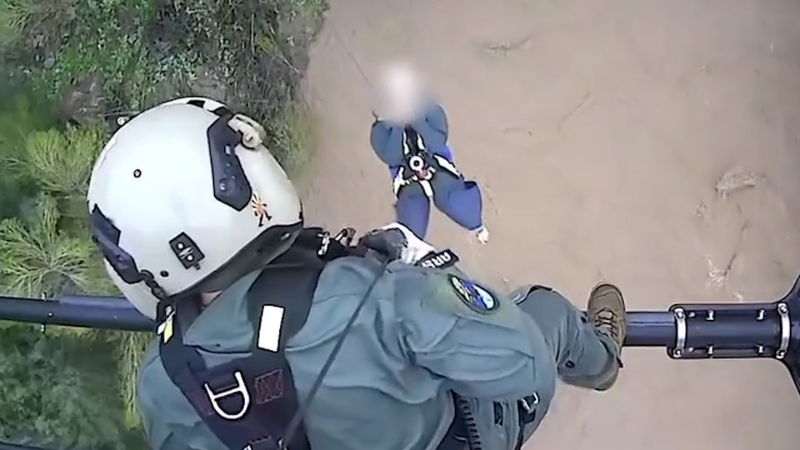'Completely dry': Why did Los Angeles firefighters run out of water?
Firefighters struggle with water shortages and some dry fire hydrants as wildfires devastate communities, highlighting the limitations of urban water systems.

A firefighter battles the Eaton Fire on Jan. 8, 2025 in Altadena, Calif. (AP Photo/Ethan Swope)
“Completely dry — couldn’t get any water out of it,” said Captain Kevin Easton, who was part of a firefighting patrol battling flames that were quickly engulfing the Pacific Palisades in the Los Angeles area on Tuesday evening, according to The NY Times.
Firefighters in Altadena ran into the same low water pressure as they desperately tried to slow the Eaton fire. "Having dozens of fire engines battling multiple fires resulted in overuse of the water system," Pasadena Fire Chief Chad Augustin told the NY Times.
As wildfires ravage residential neighborhoods, firefighters in Los Angeles County and other regions are discovering that the water systems are unable to meet the increased demand. Water experts say the infrastructure limitations are a common feature of many urban water systems.

Firefighters extinguish burning embers at a house on Santa Rosa Avenue, also known as Christmas Tree Lane, after the house was destroyed by the Eaton Fire on Jan. 9, 2025, in Altadena, Calif. (AP Photo/Chris Pizzello)
“Local water systems are usually designed to fight local, small-scale fires over a limited time period,” Kathryn Sorensen, director of research at Arizona State University’s Kyl Center for Water Policy told The LA Times. “They are not generally designed to fight large, long-lasting wildfires.”
“We are looking at a situation that is just completely not part of any domestic water system design,” Marty Adams echoed. Adams is a former general manager and chief engineer at the Los Angeles Department of Water and Power, which is responsible for delivering water to nearly 4 million residents of Los Angeles.
Municipal water systems are designed so firefighters can use multiple hydrants at once, allowing a steady flow of water to fight a large structure fire or several burning homes in a small area. However, this system was not designed for a massive wildfire burning entire neighborhoods. Amid wildfires, like the historic fires ravaging Southern California this week, the system fails.
Firefighters used a bulldozer to clear abandoned cars on Sunset Boulevard in Pacific Palisades, Los Angeles, as the Palisades fire burned 11,802 acres and threatened homes on Jan. 7.
Topography is also a factor. Transporting water to hillside communities like the Pacific Palisades can be difficult. Water must be pumped up to three hilltop storage tanks, each with a capacity of about 1 million gallons. The water can then flow downhill into homes and fire hydrants.
According to The Associated Press, The Los Angeles Department of Water and Power was pumping from aqueducts and groundwater into the system, but "demand was so high that it wasn’t enough to refill three 1-million gallon tanks in hilly Pacific Palisades that help pressurize hydrants for the neighborhood."
The AP added that Janisse Quiñones, head of the Los Angeles Department of Water and Power, said 3 million gallons of water were available when the Palisades fire started, but the demand was four times greater than “we’ve ever seen in the system.”
Los Angeles Mayor Bass estimated 20% of hydrants went dry.
The existing water system in Los Angeles has “severe limits,” Gregory Pierce, director of the UCLA Water Resources Group told The LA Times. “At least the way we’ve always built systems and wanted to pay for systems, you can’t really expect systems, even like DWP’s (Los Angeles Department of Water and Power), to be prepared for this.”
With city fire hydrants running dry during major, wind-driven fires, firefighters have contingency plans to provide their own water using tanker trucks, said Arthur Lester, a spokesperson for the L.A. County Fire Department.

A firefighter communicates in front of the advancing Kenneth Fire in the West Hills section of Los Angeles on Jan. 9, 2025. (AP Photo/Ethan Swope)
By Thursday evening, Kristin M. Crowley, the chief of the Los Angeles Fire Department, said firefighters had stopped tapping into fire hydrants. Crowley said firefighters had trained for the possibility of running out of water while battling brush fires and would typically resort to utilizing the aircraft that drop retardant and water.
But with firefighting aircraft grounded because high winds made it unsafe to make their usual aerial drops, the water situation was made exponentially worse.
Pierce echoed the concerns over water systems that are designed for urban fires, not fast-moving wildfires. However, redesigning water systems to fight the massive wildfires California is increasingly experiencing would be enormously expensive, he said.
When news of the dry fire hydrants spread across the internet, many on social media questioned why the ocean isn't used to fight wildfires. While saltwater can be effective when tackling a fire, it's not good to use regularly. It can be environmentally damaging, sometimes killing off the ecosystems where it's used for years, according to technology.org. Seawater is also corrosive to firefighting equipment like hoses, hydrants and tanks.
“We are looking at a situation that is just completely not part of any domestic water system design,” former water engineer Mary Adams said. “If this is going to be a norm, there is going to have to be some new thinking about how systems are designed.”
Adams said a more fundamental question is whether to rebuild neighborhoods next to wildlands amid climate change that is increasing the frequency and intensity of wildfires.
Report a Typo
















